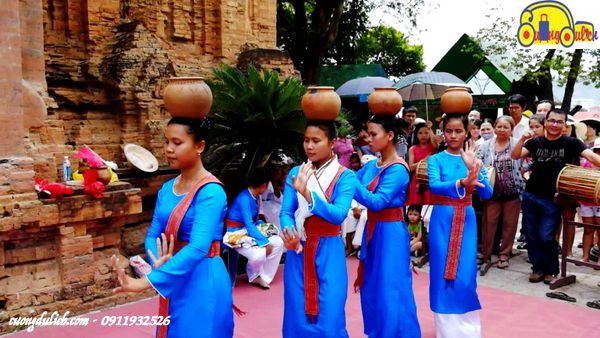Hello everyone, according to the needs of relatives who are preparing to go on a Nha Trang tour, one of the most beautiful coastal cities in Vietnam today. However, Nha Trang tourism is not just about swimming, island hopping, or having fun at Vinpearl Land. When traveling to Nha Trang, besides enjoying leisure activities, you can also learn about the culture, history, and experience mud bath services. Speaking of culture and history, in Nha Trang, there is the famous PoNagar Cham Tower. Although this is an architectural work of the Cham people, it is considered one of the symbols of Nha Trang tourism. Therefore, many of you who travel to Nha Trang and want to experience something interesting beyond the islands, are invited to go straight to PoNagar Cham Tower. And to learn more about this famous Nha Trang tourist destination, today Cuong will write a review about the PoNagar Cham Tower for everyone to research and plan for their upcoming Nha Trang tour.
See more: Don’t Forget 15 Hottest “NHA TRANG” Tourist Destinations in 2019
1. PoNagar Cham Tower – Where is it located?
PoNagar Cham Tower is a famous Nha Trang tourist destination located to the north of the city, right at the foot of Xom Bong Bridge (parallel to Tran Phu Bridge) at the intersection with Thap Ba Street. Just mentioning this place will make many of you chuckle at the name! Don’t get it wrong, it’s called Xom Bong because of the Bong dance of the locals here, not like a 3D dormitory area. Po Nagar Tower is located on Cu Lao Hill, next to Cai River mouth, only about 2km north of the city center and about 4km from the central beach of Nha Trang city. Therefore, PoNagar Cham Tower naturally becomes a famous Nha Trang tourist destination attracting many visitors to visit and pray for a prosperous and peaceful life. PoNagar Cham Tower is often referred to by locals as Thap Ba for short. So, if you are traveling to Nha Trang independently and want to visit this tourist destination in Nha Trang, just ask the locals for directions to Thap Ba. Po Nagar Tower, built by the Cham people, is located on a hill next to the Cai River – the largest river in Nha Trang, overlooking Xom Bong Bridge. If you visit the tower and are lucky, you will have the opportunity to enjoy this dance performed by Cham actors, which is very unique.
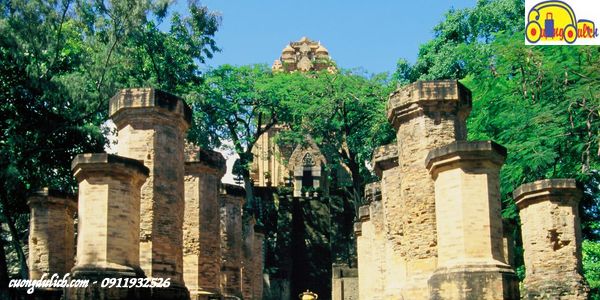
PoNagar Cham Tower is not a single tower but a complex of towers, each dedicated to a different deity, with the main tower reaching a height of 23m and is dedicated to the goddess Po Nagar. People often use the name of the main tower to refer to the entire architectural complex. The Po Nagar Festival is held annually from the 21st to the 23rd of the 3rd lunar month, so if you visit Nha Trang during this time, don’t miss it, or you will regret it!
Moreover, this is also one of the most sacred places in Nha Trang and attracts many local people to come and worship. If you are looking to conceive, you should visit here as locals say it is very spiritual.
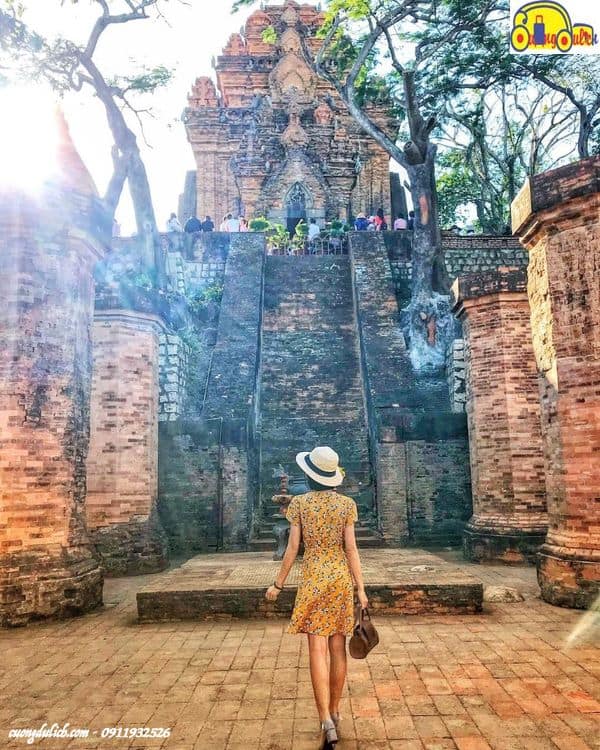
Not only that, the complex of Po Nagar Cham Towers has been evaluated by archaeologists as still preserving many unique and relatively complete architectural structures. It is not just a historical mark of the ancient Cham civilization’s architecture, but also preserves to this day unique customs and traditions, such as the Po Nagar Festival held from the 21st to the 23rd of the 3rd lunar month annually as mentioned above. Additionally, it is worth noting that this festival has been ranked by the Ministry of Culture and Information of Vietnam as one of the 16 national festivals, a unique cultural heritage with shadow puppetry and the tradition of seeking Bà’s blessing.
Moreover, Po Nagar Cham Towers have inspired spiritual life and have been depicted in poetry with a mysterious and captivating beauty:
“Who releases Trầm! White clouds linger
Soft lines winding AP SA RA legendary
Po Nagar releases the soul of Cù Lao, the Cái River
Flames flicker quietly, Ghi-Năng drum”
In 1979, Po Nagar Towers were classified as a National Monument by the Ministry of Culture and Information, demonstrating the importance and unique human values of the ancient architectural construction and cultural heritage of the Champa people within the Vietnamese cultural community. Despite enduring over 10 centuries of harsh destruction from time and wars, the Po Nagar Cham Towers complex still stands the test of time. Po Nagar Towers continue to be restored, preserved, and promoted as a place for cultural activities and festivals that embody the essence of Vietnamese culture up to this day.
2. History of this place
Historically, the Po Nagar Cham Towers archaeological site is one of the largest architectural complexes belonging to the Champa culture in Central Vietnam, built from the 8th to the 13th century during the Hindu (Indian religion) period when the Champa kingdom was flourishing.
The overall architecture of Ponagar consists of 3 levels, from bottom to top. At the lower level, at ground level, is an ancient tower gate that no longer exists today. From there, there are stone steps leading up to the middle level. At the middle level called Mandapa (not Wakanda), meaning a guest house, a place of tranquility for pilgrims to rest and prepare offerings. Mandapa is 20m long, 15m wide, with 4 octagonal columns (including 10 large columns and 12 small columns). On the bodies of the large columns are deep holes, carved into the column bodies, symmetrically aligned with the tops of the small columns.
The top level is where the main towers are located. The towers are built in the Cham style with tightly interlocking bricks and no visible mortar (Cuong feels like modern construction methods may not even match those of the past). The main worship tower in the front row is quite large and tall, about 23 meters high, which is the Po Nagar tower.
The tower has 4 levels, each level has doors, stone statues, and animal figures. Inside is a stone statue of a goddess (2.6m tall) carved from black granite (previously sandalwood, and even further back, gold) sitting on a majestic stone pedestal, leaning against a large stone slab shaped like a lotus leaf. This is a masterpiece of Cham sculpture, a harmonious combination of round sculpture and bas-relief. Although Cuong doesn’t understand these things much, they are truly beautiful, and on the top of the tower, there is also a statue of the god Shiva riding the divine bull Nandin, and various mythical creatures like swans, goats, elephants, and clouds.
LEGEND OF PO NAGAR TOWER
According to the legend, long ago on Dai An Mountain, there was a peasant couple who built a house and cultivated melons on the mountainside. For a long time, every ripe melon would disappear. The old man watched and one day caught a girl about 9-10 years old picking melons and playing under the moonlight. Seeing the cute girl, he took her home to raise and love as his own. That day, it rained heavily and the wind blew, the scenery was desolate, the girl made three stone statues and picked flowers to decorate and stood admiring them. Thinking her behavior was inappropriate, the old man scolded her loudly. Unbeknownst to him, the girl was a celestial being who missed the heavenly scene. Feeling sad and longing, she saw a piece of driftwood floating by, and the girl sacrificed herself to the driftwood to be carried away by the waves. The driftwood drifted to the sea and washed ashore near the palace, emitting a fragrant scent. The local people were curious and came to see. Seeing the good wood, they tried to lift it, but no matter how many people gathered, they couldn’t lift it. Prince Bac Hai heard the rumors and came to see the truth, raising his hand to try. Strangely, the wood suddenly became light as a feather, so he brought it to the palace and cherished it as a treasure. One night, under the dim moonlight, the prince saw a faint figure near the driftwood, but when he approached, it was empty, only the faint scent of the driftwood wafted out. In the following nights, the prince continued to watch… Then one night, he saw a stunning woman step out of the driftwood. He ran to embrace the woman. Unable to transform back into the driftwood, the woman followed the prince back to the palace and revealed her name as Thiên Y Ana. The prince found the extraordinary beauty of Ana different and asked the king for permission to marry her. The couple lived happily, giving birth to two children – a boy and a girl, both handsome and beautiful. One day, the longing for their homeland urged Thiên Y to take her two children back into the driftwood to return to the old village. Dai An Mountain was still there, but the peasant couple had passed away. Thiên Y built a tomb for her foster parents and repaired the house to live in. Seeing the local people still backward, she taught them to plow, weave, and perform rituals… From then on, the fields were always fertile, and the people’s lives became more prosperous every day. One day, a crane flew down from the sky, Thiên Y and her two children rode the crane back to the sky… The people remembered the gratitude for her building the tower and statues for worship, and every year on the 23rd of the 3rd lunar month, they held a flower offering ceremony.
The legend has long been closed, leaving only the hopeful thoughts of those who are still waiting. Sitting next to the tower, the wind from the Cai River blows into the heart, dispelling the vague thoughts to return to Po Nagar. The beautiful Bong Bridge still watches the flowing waters every day and always follows the changes of time. Next to it is the dreamy villages of Con and Bong that have entered the poetry of many generations.
When visiting Po Nagar Cham Towers, besides learning about history, architecture, and spirituality, visitors also have the opportunity to enjoy Cham-pa dances performed by the Cham ethnic dance troupe. The Cham-pa dances enchant visitors, leaving them with a beautiful impression when visiting this revered place.
CHAM PEOPLE’S LEGEND
Queen Po Nagar – also known as Yan Pu Nagara, Po Ino Nagar, or the Black Lady (referred to as Thiên Y Thánh Mẫu Ana in Vietnamese) – is a goddess created from the sky’s clouds and sea foam, who created the earth, produced precious wood, plants, and rice. She had 97 husbands, of which only Po Yan Amo had authority and was respected above all. She had 38 daughters, all of whom transformed into goddesses, including three chosen by the Cham people to be the land’s protective deities and still worshipped to this day: Po Nagar Dara, the goddess Kauthara (Khanh Hoa); Po Rarai Anaih, the goddess Panduranga (Ninh Thuan); and Po Bia Tikuk, the goddess Manthit (Phan Thiet).
According to tradition, the statue of Thiên Y Thánh Mẫu Ana in the Cham people’s rich beliefs did not wear clothes, but Po Nagar is now used by the Vietnamese and has dressed the goddess in a Buddhist style. The temple at Po Nagar Cham Towers is very famous among tourists.
3. How to get there?
To get to Thap Ba PoNagar, the easiest route for everyone is to head towards the Nha Trang coastal road, which is Tran Phu street, then turn left towards Tran Phu Bridge. Once you have crossed Tran Phu Bridge, turn left again onto Thap Ba street at the first traffic light intersection, don’t go too far or you will end up spending extra money on that road. Follow Thap Ba street until you see the PoNagar Tower tourist area, don’t look around too far because the sign for PoNagar Tower is very prominent. The good thing is that this is a coastal city, so the air is very fresh and less dusty. However, Thap Ba street is a bit narrow and occasionally has speed bumps, so if you are prone to motion sickness or dislike the smell of car air conditioning, bring some bread or citrus peels to help with motion sickness, or you can switch to a motorbike rental for around 120k-150k depending on where you rent from. Cuong always rents a hotel’s motorbike for 150k and adds 50k for gas, giving Cuong the ability to explore Nha Trang city that day instead of paying around 30-50k for a taxi just to take Cuong from the hotel to there. However, if you choose to ride a motorbike, remember to bring sunscreen because Nha Trang is very sunny from around 9-10 am.
4. What’s at Thap Ba PoNagar?
Enjoy free Cham dance performances
Thap Ba PoNagar is the first and only place in Vietnam to regularly showcase Cham dance, so you will get to enjoy traditional Cham Pa dances performed by Cham people, including skilled drum and horn players, and young women performing dances. So when you visit Thap Ba PoNagar in Nha Trang, don’t miss this performance. This activity is usually held every evening and not only helps preserve the beauty of Cham culture but also contributes to introducing the regional culture to international tourists and the world.
Ponagar Tower Festival in Nha Trang (held annually from the 21st to the 23rd of the 3rd lunar month)
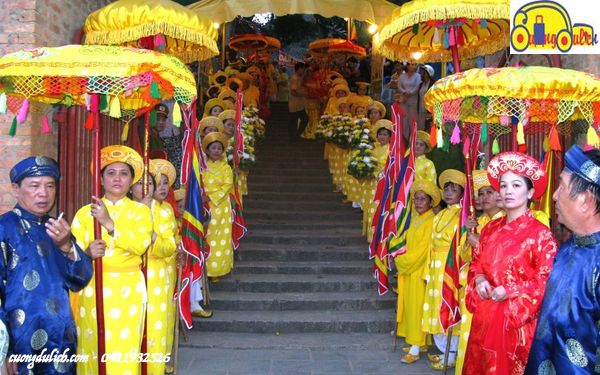
As Cuong mentioned above, the Thap Ba Festival in Nha Trang is one of the largest cultural events in the South Central and Central Highlands region, ranked as one of the 16 national-level festivals. During the festival, visitors can witness traditional rituals such as statue bathing, costume changing ceremonies, offerings and sacrifices, especially the lantern floating ceremony on the river on the night of the 20th of the lunar March. It sounds very romantic, right? If any guys want to confess their love to their girlfriends, choosing the night of the 20th of the lunar March and confessing by the sparkling lantern-lit river, Cuong believes the girls will be immediately touched. There are also processions, fruit offerings on the afternoon of the 23rd, and performances of shadow puppetry, singing, and dancing taking place throughout the festival days on the main stage in front of the tower. So, if you have the opportunity to visit Nha Trang during this time, make sure to participate in the festival as it is very unique and will give you a new perspective on ancient traditional culture.
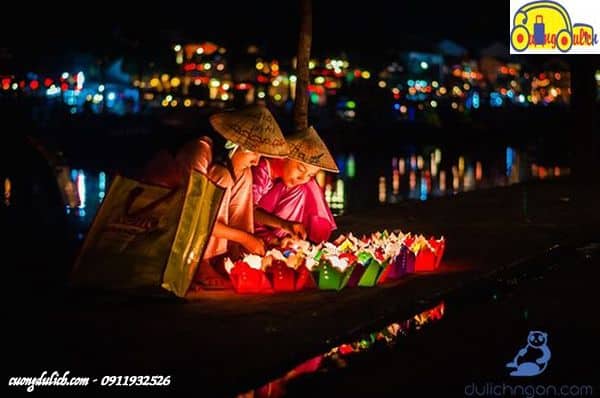
Unique ancient Cham architectural complex
Although the entire scale of Thap Ba in Nha Trang is not really grand, it still attracts about 160,000 tourists annually. The reason is that this structure has existed for over 10 centuries and is one of the typical architectural and sculptural works of the Cham people. The complex is divided into 3 levels, consisting of 4 large towers. Although it is now just ruins, the sculptural shapes and the color of baked clay seem to cover a layer of mystery about the traces of a once prosperous civilization.
When visiting PoNagar Temple, you will not only discover many wonderful corners but also explore 3 different levels of sightseeing: the entrance gate – the meditation house, the guest house – the main tower of PoNagar.
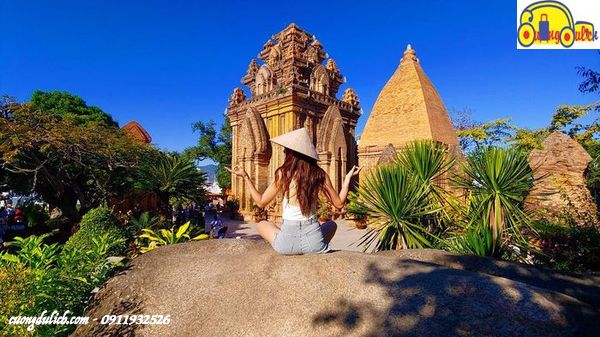
- Floor 1: This is where you start your journey to explore the Po Nagar Tower, this floor is just a passage with consecutive stairs leading you to the next floor and climbing up is a bit tiring but Cuong guarantees it’s worth it.
Floor 2: After finishing floor 1, you will reach floor 2 of the Po Nagar Tower, a floor for resting or changing clothes, offerings to the goddess Po Nagar. This floor currently has octagonal brick columns, existing for thousands of years, so it’s quite mossy. These columns make the Po Nagar Tower more majestic and solemn.
Floor 3: The final floor of the Po Nagar Tower complex has 2 main towers, and the tallest tower is where Mother of the Land is worshipped, the goddess Po Nagar. With its unique and distinctive architecture, the Po Nagar Tower is an ideal tourist destination for visitors to Nha Trang.
Main Tower: When you reach floor 3 of the Po Nagar Tower, you will encounter the Main Tower facing Northeast with a height of 23m, inside worshipping the goddess Po Nagar. The Main Tower has a very unique design, with 5 vertical columns running along the wall, 4 corners are 4 smaller towers with 3 gradually smaller roofs, and on the vault are stone bas-reliefs.
South Tower: 18m tall, the second largest tower after the main tower worshipping the goddess Po Nagar, this tower is called the Mr. Tower, worshipping the god Shiva (husband of the goddess Po Nagar).
Northwest Tower: 9m tall, the third largest tower, worshipping the god Ganesha (god of happiness, luck, and wisdom), according to legend, this is the tower worshipping the son of the goddess Po Nagar.
Southeast Tower: 7m tall, the last tower of the Po Nagar Tower complex and the smallest tower, this is the tower worshipping the god Skandha – son of Shiva (symbolizing strength and war).
Inscription Stone: At the Po Nagar Tower, you will see 4 stone tablets telling the legend of Lady Thiên Y A Na (Po Nagar), including 1 tablet engraved with Han-Nom characters, erected in 1856. The second tablet was erected in 1871, the third in 1972 in Vietnamese script, and the last tablet was erected in 2010.
Entertainment and accommodation services at the Po Nagar Tower tourist area (about 2.6 km from Po Nagar Tower)
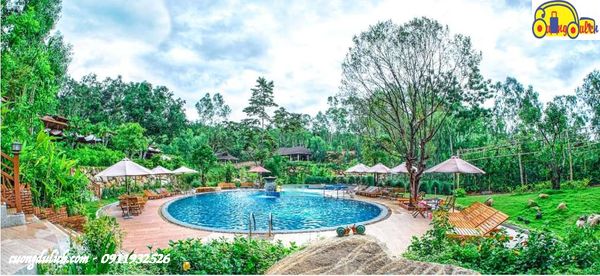
Mud bathing has long been known as a therapy that brings many benefits, especially for human health. It is formed from the transformation of substances, originating from plant species buried with the earth, so mud is believed to have healing properties and many effects in supporting human health such as joint inflammation or nerve pain. Relaxing, releasing tension, soaking silently in a tub full of mineral mud also has a high effect in reducing stress. Therefore, Cuong confidently states that mud bathing is truly suitable for everyone from young to old, from men to women, and so on.
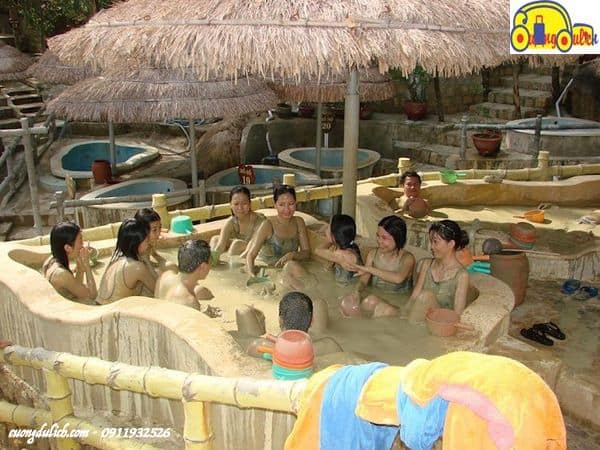
At the end of the day, after all the fun, we can visit Thap Ba to soak in the mineral mud to relieve the fatigue of a whole day of wandering, soothe the body, and wash away the blazing sun of the coastal city. Depending on the ticket you purchase, you can choose between communal bath tubs or individual tubs and go through different steps, but basically, you will soak in mineral mud for about 20 minutes and soak in hot mineral water for another 20 minutes, not to mention the cleaning process.
Immersing yourself in mineral mud is quite an interesting experience. At first, it may feel strange, like Cuong’s first time trying it, but once you get used to it, you will start to feel extremely refreshing. The layers of mud enveloping you seem to remove all fatigue, gently massaging your body and making you feel rejuvenated as in a legend. This therapy is very popular and an experience that you may not find everywhere.
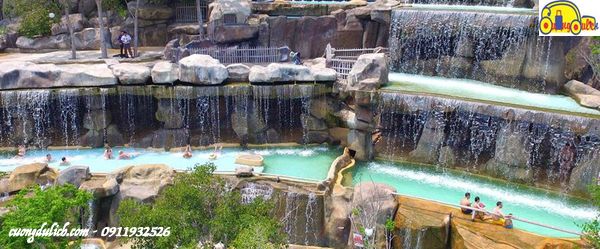
After soaking in mud and cleaning off all the mud layer, you will be led to soak in a natural hot mineral water tub. We already know that hot water baths have been determined to have many health benefits and natural mineral water is even better because of its gentle nature from nature. Soaking in a hot water tub, feeling all the fatigue being released through the expansion of pores, you will feel your whole body light and refreshed, washing away all the dirt and tiredness of the day, and believe me, at that moment it feels like we are lost in a fairyland. Most people who come to Nha Trang tourism choose Thap Ba as a stopping point or must-visit spot for their trip, and if you want to relax after a long day of traveling, especially when you have visited all of the PoNagar towers, then the Thap Ba mud bath in Nha Trang is definitely an experience you shouldn’t miss.
Oh, and as for the service prices, you can check them below, Cuong has posted the service price list for you to refer to.
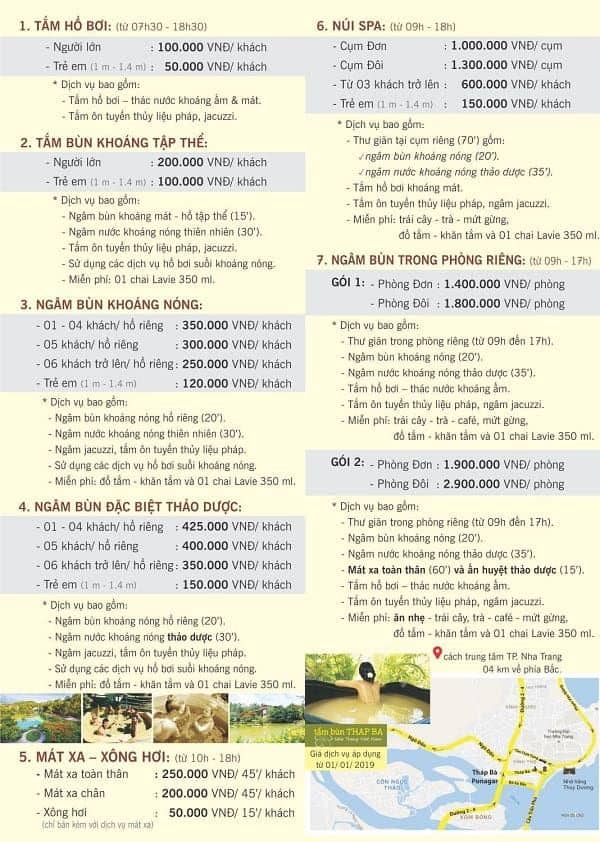
5. Entrance fees?
With a very affordable ticket price of 22k/person and a parking fee of 3k/motorbike. It can be said that the ticket price is very cheap for us to visit, worship, enjoy the unique Cham dance and see the vivid photos that are truly impressive. As for the price list of mud bath and mineral bath services at the Thap Ba tourist area below, this is a reasonable or even cheap price for you to have the opportunity to enjoy such top-notch relaxation services for your body.
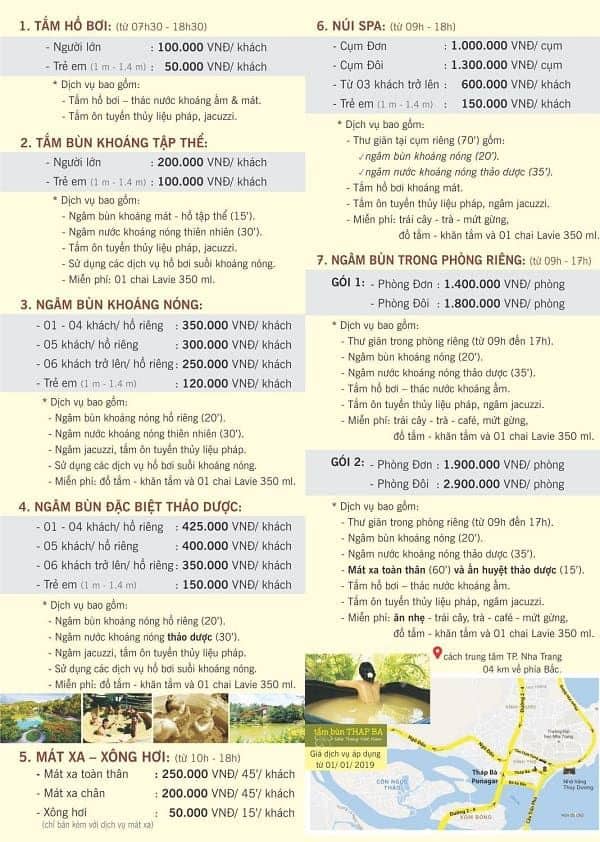
6. Other experiences.
If you have a lot of energy and are capable of doing more, you can combine a visit to Long Son Pagoda in the morning and Thap Ba in the afternoon, then go for a mud bath in the evening or replace Long Son Pagoda with the Institute of Oceanography as both places are not far from Thap Ba PoNagar. Or you can take the Nha Trang Tour to visit all 4 places in one day if you have limited time but still want to explore everything, which is also a reasonable option.
7. What about dining?
Of course, when traveling, you always want to explore the dining options, right? That’s why Cuong will review some places that are really worth trying after visiting Thap Ba PoNagar. At Thap Ba PoNagar, you can enjoy light snacks like ice cream or coconut water here because there’s nothing better than having an ice cream or a refreshing coconut water after sightseeing and taking some memorable photos, right? If you want to taste the specialties of the coastal city of Nha Trang after your visit, you can also head to seafood restaurants near Thap Ba PoNagar. Among them, there are 3 places that Cuong really likes and are very famous:
- Seafood Bờ Kè Nha Trang
- Seafood restaurant on Thap Ba street
- Seafood restaurant on Pham Van Dong street

Nha Trang Riverside Seafood is located in a very prime location right on the Thap Ba riverside, so it’s always very cool. When dining on seafood here, you will also have the opportunity to admire two famous bridges in the city, Xom Bong Bridge and Tran Phu Bridge, and at the same time, you can also admire the beautiful PoNagar Tower from a distance. Not to mention, this is one of the best seafood restaurants in Nha Trang where you can not only enjoy delicious seafood dishes that will make you crave just by thinking about them, but also immerse yourself in the beautiful scenery of Nha Trang to feel the cool sea breeze and the salty taste of the sea. At Nha Trang Riverside Seafood, you can choose from “premium” seafood dishes such as steamed grouper with lagim sauce or crab with tamarind sauce, garlic butter lobster… and even “common” dishes like snails with garlic butter, snails with tamarind sauce to nibble on. What could be better than sitting back, enjoying the seaside atmosphere, savoring the famous dishes of the coastal city of Nha Trang, and admiring the PoNagar Tower from afar.
Thap Ba Seafood Restaurants are located right on Thap Ba Street, where you pass by to get to PoNagar Tower. Along this street, there are dozens of sidewalk seafood stalls for you to choose from. Here, you can also enjoy some incredibly delicious specialties with flavors that are not easily found in any seafood restaurant or street food stall you’ve ever tried. Especially for those who love snails, you can visit Xuan Anh Snail Restaurant or Coconut Tree Snail Restaurant, where Cuong finds that they serve the most delicious and unique snail dishes not only on this street but in the entire city of Nha Trang.

Quán Xuân Anh (9C Tháp Bà) although a bit small, it has a warm atmosphere, friendly and attentive service staff, and the snail salad is exceptionally delicious.

Coconut Tree Restaurant (247 KA Thap Ba) has the advantage of having dipping sauce made according to a “traditional” recipe, so it is very special and unique that Cuong has not found any other snail restaurant with sauce as delicious as this one, let alone better.
Seafood restaurants on Pham Van Dong street although it is a small and beautiful street in the coastal city of Nha Trang, this place “hides” the famous seafood restaurants in Nha Trang. Among them, there are 2 dining spots that Cuong finds the most delicious and you can visit on this street:
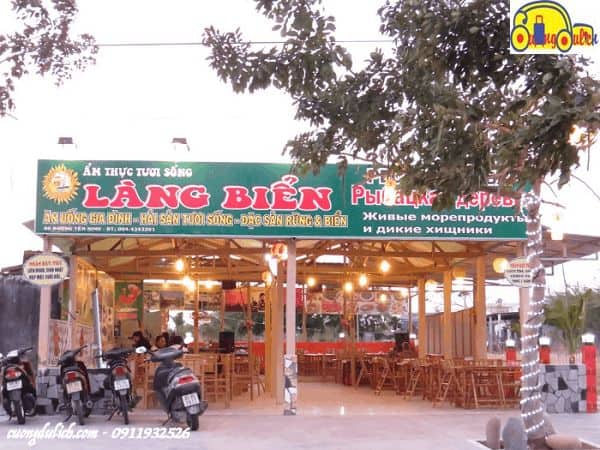
Quán Làng Biển (9C Phạm Văn Đồng): The food is delicious and reasonably priced, with prices ranging from 30,000 to 200,000 Vietnamese dong. You can enjoy grilled shrimp, steamed crabs, or seafood salad… Cuong must admit that this place is perfect for groups of friends who want to enjoy delicious seafood at an affordable price.

Thuy Duong Restaurant (01 Pham Van Dong Street): If you want to enjoy a meal while admiring the panoramic view of Nha Trang city, Thuy Duong Restaurant is one of the best seafood restaurants in Nha Trang. With its beachfront location, outdoor seating, and a stunning view of Nha Trang city at night, this place is truly romantic and ideal for couples to enjoy the atmosphere, sounds of the sea, the food, and the beautiful Nha Trang city view. Especially if you visit the restaurant on a full moon night, it’s a perfect place for men to confess their love or propose to their significant other.
8. Things to Note When Visiting and Enjoying Here
– As this is a sacred place for the Cham people, please do not litter or speak disrespectfully or use vulgar language about this goddess.
– In the evening along Thap Ba Street, there are many delicious and affordable foods being sold, so visiting Thap Ba in the afternoon is most suitable, or you can go in the morning to have more time to enjoy mud baths, massages, and steam baths for relaxation.
– Chinese tourists visiting Po Nagar Cham Towers are quite numerous, so you may be mistaken for a Chinese person.
– Remember to bring a hat or umbrella and sunglasses if you go when it’s sunny.
– When entering the incense burning chamber, you should wear long clothes, not wear glasses or hats, not wear off-shoulder tops, and wear pants/skirts above the knees. If you accidentally wear too short clothes, don’t worry because you can wear a blue robe outside (provided for free on the left side of the main tower).
– The dance troupe usually performs in the afternoon, so those who go in the morning won’t have the chance to see it.
– Please follow the signs and notices here and do not pose for inappropriate photos or litter within the tower area.
Above is a brief review of Po Nagar Cham Towers tourist site. I’m sure this will be one of the most unforgettable and interesting experiences that you shouldn’t miss when visiting Nha Trang. I hope these sharing will be helpful for your upcoming trip to Nha Trang. Please continue to like, share, and subscribe to receive more videos and travel experience reviews from Cuong. Thank you.


